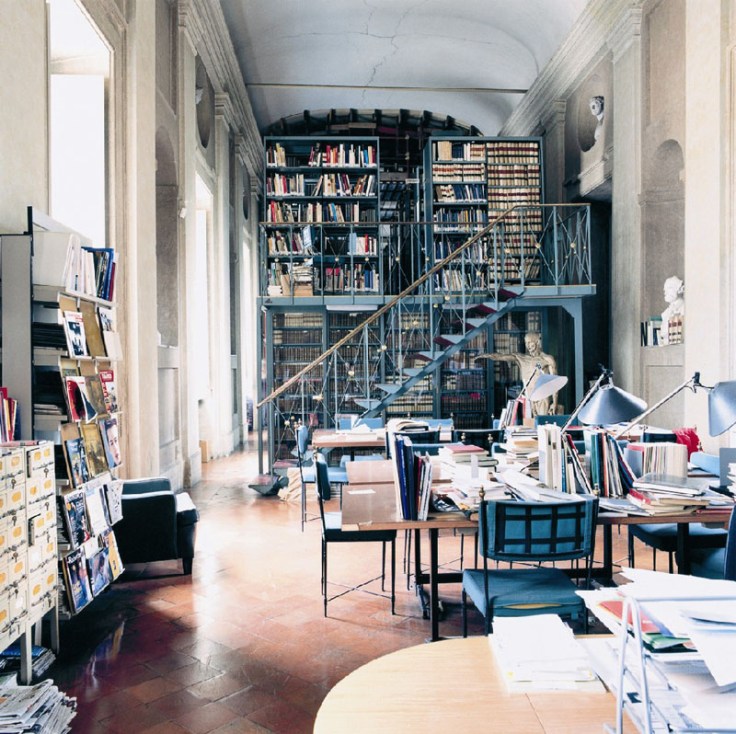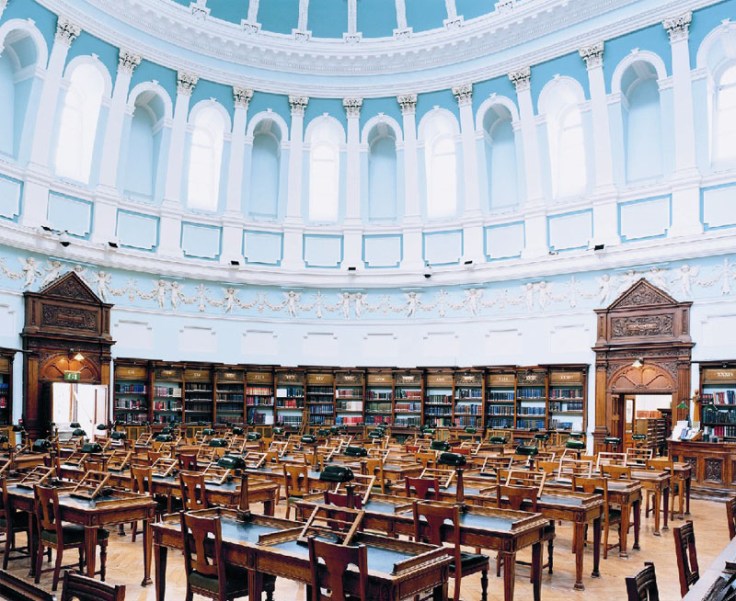
Copyright 2005, Candida Höfer courtesy Schrimer/Mosel Verlag
I like libraries. I like the smell of books; old leather covers or the fresh ink recently laid on new sheets. I like to wonder along the library isles among the towering columns of books, getting lost physically and in thought. And I am a photobook collector with a slowly growing personal library. Thus Candida Höfer’s book, Libraries, published by Schirmer/Mosel, which documents some wonderful libraries from all over the world is very appealing to me.
Höfer’s photographs investigates what a library might be. The potential definitions of a library include: a building that houses a collection of books and other materials, a depository built to contain books and other materials for reading and study, a collection of literary documents or records kept for reference or borrowing, and a room where books are kept. Essentially she shows that the concept of a library is a diverse and complex subject.
She has photographed the interior of libraries far and wide and on occasion features an exterior view but even those are taken at mid-range, not placing a library into a larger urban context. Predominately it is the inner core of the library structure that constitutes the content of this book; the halls, book lined shelves, the reading areas and halls, the vast array of index cards cases, as well as the lines of computer terminals. There are glimpses of messy work areas, inner book stacks, empty shelving awaiting their ensuing loads, and statuary lined corridors. The books when seen from afar appear like abstract drawings on the walls. When the books are documented up close I can examine the details of worn and well handled bindings and casings, testimonials to an ancient time.
The books held within the libraries are shown as valuable treasures protected by boundaries, fences, and isolated away from the general public. These books are not readily accessible but seen from a distance for us to wonder what might be hidden within the leather bound covers. We also see books that appear to be readily available, unprotected, and vulnerable and out in the open. Available books could symbolize that knowledge is also there to be found, considered and subsequently applied.
Her photographs dive into the psychology of social architecture, where buildings and infrastructure can reflect cultural identity. Building can seem to be oppressive, intimidating, contemporary, open, seductive, proud, pompous, accessible, inhospitable, showy and ostentatious. How the surface of a building and its architectural infrastructure effects you depends on your cultural perspective. While I see very ornate detail work and think that this is too ostentatious, others may think this is proper and entirely appropriate. It would seem that Höfer does not seem to make any judgments, but documents what she finds, which I think is too simple of an assessment.
Höfer’s photographs are in the Düsseldorf style of Bern and Hiller Beacher, with whom she studied. Stylistically this book is a comparative study of various library systems, a typology document. Her photographs include content that can be examined for a comparison of libraries between different geographic and cultural locations. There are libraries in Italy, Germany, United States, Austria, Brazil, France, Czech Republic, Switzerland, Sweden, Mexico, Norway, Spain, and Finland. There are detailed color photographs of libraries within a nation that reflect regional cultural or social differences, such as a schloss (castle or royal) library versus the university or that of the main city (public) library. These are made with a large format camera, utilizing a small aperture, so that all the content within the photograph is tack sharp and stunning.
But unlike the Beacher’s methodology she does not strive to find the same exact compositional arrangement for each of her libraries. It appears to me that she has allowed the individuality of each library to speak to her. Another difference with the Beacher’s is her use of color photographs. Thus there is richness in the variety of the photographic content as I move from page to page that I do not necessarily find with the Beacher’s typographic subjects.
Similar to the Beacher’s work, almost every photograph excludes the direct presence of human activity. I believe that this method allows us to study the basic and underlying design of a structure. With her photographs, I can visualize the organization of the place itself with more clarity. Without the people present, she places an emphasis on the form that supports the function. Nevertheless, I can also see traces of those who have designed, built, organized, and maintained these spaces.
One of a handful of exceptions to the exclusions of humanity is the wonderful photograph of the library of St Galan, first photograph below. I find it one of the more beautiful photographs in the book. For me, the ghost like forms of the people who seem to only momentarily linger within the library speaks to the fleeting spirit of those who come to visit the books. Meanwhile the book, like knowledge, will preserver and exist long after we are gone. The books also contain the traces and memories of mankind, those who dreamed, wrote, printed, bound and subsequently cared for these books and documents.
She also documents what libraries were, have become and a hint of what they might evolve into. With the internet and instant access to a wide range of knowledge, we might think of books and libraries becoming passé. Nevertheless, bookstores are doing well, the number of photobooks seem to be increasing and the general interest in book seems strong. Good books need good homes, and the natural place for them being a library. Thus, I think that there is a very good chance that these beautiful libraries will still be with us a bit longer, although their internal organizations will surly change.
Höfer’s book is a delightful study of library structures and organization, reflecting social identities. It provides possibilities where books & knowledge can hide. I enjoyed the introductory essay by Umberto Eco about the essence of libraries and I even experienced wonderful flashbacks to when as an undergraduate I found a sneaky passage into the forbidden “stacks” at my university library.
Cheers, Douglas Stockdale




by Douglas Stockdale
beautiful photographs!
Now that’s what I call a library.
Beatiful photos.I would like just be in every of these places and hid myself up there and read,read,read.There is some mystery in there.Thats what drives to read.You never know what You gonna find,do You?
I would do anything to find this book. Looked all over the net and all over New York City! help!
I just did a quick check with my contacts and there are a few copies available, one in the UK, one in The Netherlands and another in India.